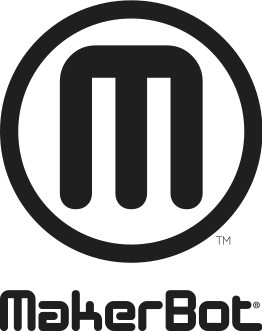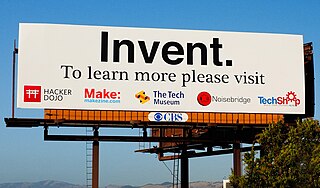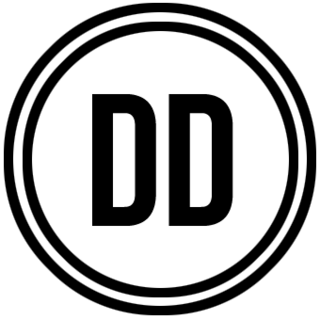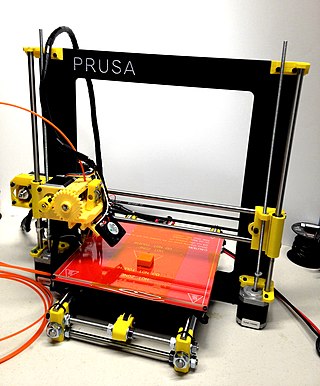
The open-design movement involves the development of physical products, machines and systems through use of publicly shared design information. This includes the making of both free and open-source software (FOSS) as well as open-source hardware. The process is generally facilitated by the Internet and often performed without monetary compensation. The goals and philosophy of the movement are identical to that of the open-source movement, but are implemented for the development of physical products rather than software. Open design is a form of co-creation, where the final product is designed by the users, rather than an external stakeholder such as a private company.

RepRap is a project to develop low-cost 3D printers that can print most of their own components. As open designs, all of the designs produced by the project are released under a free software license, the GNU General Public License.

Stratasys, Ltd. is an American-Israeli manufacturer of 3D printers, software, and materials for polymer additive manufacturing as well as 3D-printed parts on-demand. The company is incorporated in Israel. Engineers use Stratasys systems to model complex geometries in a wide range of polymer materials, including: ABS, polyphenylsulfone (PPSF), polycarbonate (PC) and polyetherimide and Nylon 12.

MakerBot Industries, LLC was an American desktop 3D printer manufacturer company headquartered in New York City. It was founded in January 2009 by Bre Pettis, Adam Mayer, and Zach "Hoeken" Smith to build on the early progress of the RepRap Project. It was acquired by Stratasys in June 2013. As of April 2016, MakerBot had sold over 100,000 desktop 3D printers worldwide. Between 2009 and 2019, the company released 7 generations of 3D printers, ending with the METHOD and METHOD X. It was at one point the leader of the desktop market with an important presence in the media, but its market share declined over the late 2010s. MakerBot also founded and operated Thingiverse, the largest online 3D printing community and file repository. In August 2022, the company completed a merger with its long-time competitor Ultimaker. The combined company is known as UltiMaker, but retains the MakerBot name for its Sketch line of education-focused 3D printers.

OpenSCAD is a free software application for creating solid 3D computer-aided design (CAD) objects. It is a script-only based modeller that uses its own description language; the 3D preview can be manipulated interactively, but cannot be interactively modified in 3D. Instead, an OpenSCAD script specifies geometric primitives and defines how they are modified and combined to render a 3D model. As such, the program performs constructive solid geometry (CSG). OpenSCAD is available for Windows, Linux, and macOS.

The maker culture is a contemporary subculture representing a technology-based extension of DIY culture that intersects with hardware-oriented parts of hacker culture and revels in the creation of new devices as well as tinkering with existing ones. The maker culture in general supports open-source hardware. Typical interests enjoyed by the maker culture include engineering-oriented pursuits such as electronics, robotics, 3-D printing, and the use of computer numeric control tools, as well as more traditional activities such as metalworking, woodworking, and, mainly, its predecessor, traditional arts and crafts.

Defense Distributed is an online, open-source hardware and software organization that develops digital schematics of firearms in CAD files, or "wiki weapons", that may be downloaded from the Internet and used in 3D printing or CNC milling applications. Among the organization's goals is to develop and freely publish firearms-related design schematics that can be downloaded and reproduced by anyone with a 3D printer or milling machine, facilitating the popular production of homemade firearms.
Printrbot is a 3D printer company created by Brook Drumm in 2011 and originally funded through Kickstarter. Printrbot printers use fused deposition modelling to manufacture 3-dimensional artifacts.

DEFCAD, Inc. is an American startup that has created a search engine and web portal for designers and hobbyists to find and develop 3D printable and other CAD models online.

GrabCAD, Inc. is a Cambridge, Massachusetts-based startup that created a free cloud-based collaboration environment that helps engineering teams manage, view and share CAD files.

Ultimaker is a 3D printer-manufacturing company based in the Netherlands, with offices and assembly lines in the US. They make fused filament fabrication 3D printers, develop 3D printing software, and sell branded 3D printing materials. Their product line includes the Ultimaker S5 and S3, Ultimaker 3 series, Ultimaker 2+ series and Ultimaker Original+. These products are used by industries such as automotive, architecture, healthcare, education, and small scale manufacturing.
A 3D printing marketplace is a website where users buy, sell and freely share digital 3D printable files for use on 3D printers. They sometimes also offer the ability to print the models and ship them to customers.
A recyclebot is an open-source hardware device for converting waste plastic into filament for open-source 3D printers like the RepRap. Making DIY 3D printer filament at home is both less costly and better for the environment than purchasing conventional 3D printer filament. In following the RepRap tradition there are recyclebot designs that use mostly 3-D printable parts.

Fused filament fabrication (FFF), also known as fused deposition modeling, or filament freeform fabrication, is a 3D printing process that uses a continuous filament of a thermoplastic material. Filament is fed from a large spool through a moving, heated printer extruder head, and is deposited on the growing work. The print head is moved under computer control to define the printed shape. Usually the head moves in two dimensions to deposit one horizontal plane, or layer, at a time; the work or the print head is then moved vertically by a small amount to begin a new layer. The speed of the extruder head may also be controlled to stop and start deposition and form an interrupted plane without stringing or dribbling between sections. "Fused filament fabrication" was coined by the members of the RepRap project to give an acronym (FFF) that would be legally unconstrained in its use.
3D Slash is a 3D modeling software application produced by Sylvain Huet.

Aleph Objects, Inc. was a small manufacturing company based in Loveland, Colorado. Their business model focused around the development of Open-source hardware for 3D printing with full support for Free and open-source software.

Pinshape Inc. is an online 3D printing community and marketplace with headquarters in Vancouver, British Columbia, Canada. It allows designers to share and sell their 3D printable designs. People with 3D printers can print those designs on their own printers.

InMoov is a humanoid robot, constructed out of 3D printable plastic body components, and controlled by Arduino microcontrollers.

Cura is an open source slicing application for 3D printers. It was created by David Braam who was later employed by Ultimaker, a 3D printer manufacturing company, to maintain the software. Cura is available under LGPLv3 license. Cura was initially released under the open source Affero General Public License version 3, but on 28 September 2017 the license was changed to LGPLv3. This change allowed for more integration with third-party CAD applications. Development is hosted on GitHub. Ultimaker Cura is used by over one million users worldwide and handles 1.4 million print jobs per week. It is the preferred 3D printing software for Ultimaker 3D printers, but it can be used with other printers as well.
Marlin is open source firmware originally designed for RepRap project FDM 3D printers using the Arduino platform.














